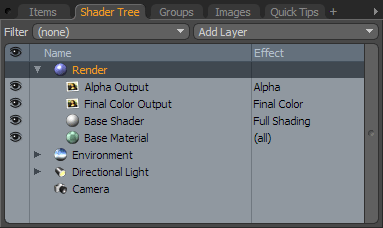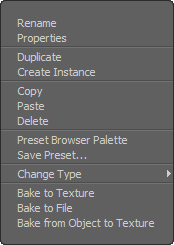The Shader Tree is the main interface for adding materials and textures to surfaces in your scene. modo uses a layered approach to texturing, allowing a simple to use, yet very powerful method for assigning textures exactly where you want them, as well as creating complex looks for surfaces with ease. The visual impact on your scene is from top to bottom; an image layer with 100% opacity that is placed above a procedural checker pattern will obscure the checkers in the rendered frame. Changing the image layers transparency would gradually reveal the checkered layer below.
The viewport itself, in the default configuration, appears in the upper right viewport group. Click its tab to make the viewport visible. Whenever a layer is selected within the viewport, its associated settings will appear in the 'Properties' viewport found directly below. If the properties are not visible, one may need to also click its tab to reveal the viewport.
Shader Tree UI--
The viewport has 3 UI modes, 'Compact', 'Small' and 'Full' . Depending on your amount of screen real estate, you can adjust the viewport by dragging any edge; it will dynamically scale giving you the appropriate set of options based on the viewports size.

In 'Compact' mode, the first four buttons represent 'R' for the render item, 'L' for lights, 'E' for environment and 'C' for camera. The bar on the right, when clicked on will pop open a contextual menu allowing the user to choose individual layers specific to each 'R', 'L', 'E; and 'C' setting. Additional layers can be added using the menu bar commands 'Texture > Add Shader Tree Layer > (choose type)'

In 'Small' mode, the 'Render', 'Light, 'Environment' and 'Camera' buttons become full size and the layer selector appears below.

In 'Full' mode, each item is represented as a layer with a corresponding icon. Clicking on any item will select it, allowing the user to edit the various properties, multiple layers can be selected using the Shift and Ctrl key modifiers. Layers can also be dragged and dropped within the viewport, changing the layer order which in turn affect how they layers feed into the render outputs, They can also be dragged into material groups for better organizing scenes with many surfaces.
Some additional controls appear above the viewport as well. The 'Filter' option will automatically show/hide various type of layers. The 'Add Layer' button will allow the user to add additional layers to the shader tree. The 'eye' icon column allows the user to enable/disable the effect of a specific layer without removing it; simply click the eye to toggle. The 'Effect' column allows the user to specify in what way the layer contributes to the rendered image, RMB-click on the effect name to open a context menu with many additional options. Any layer name, once selected, can be RMB-clicked providing a context menu with several options-
 Rename: Allows the user to assign a new name to the specific layer.
Rename: Allows the user to assign a new name to the specific layer.
Properties: Opens the 'Properties' viewport with the selected layers corresponding settings.
Duplicate: This command will create a new layer with identical settings. Changes in the original item are not reflected in the duplicate layer, nor are modification to the duplicate reflect in its original layer.
Create Instance: Creates a virtual duplicate of a layer that references the original, changes to one layer propagate to all instances.
Copy/Paste/Delete: Entire layers, as well as the settings of individual layers themselves can be copied, pasted and/or deleted using these commands. When pasting values from one layer to another, the layers must be of the same type, i.e. material to material.
Preset Browsers Palette: This command opens a 'Preset Browser' palette.
Save Preset: Any layer in the shader tree can act as a preset. When one selects 'Save Preset..." a file save dialog is presented asking where you'd like to save your preset. If you want the preset to show up automatically in the existing set, you'll need to navigate to the directory where your presets are stored and save within that directory, one can also create a new directory for saving presets, but make sure to use the '(add path)' command so you can see them within the browser viewport. Often a surface made up of multiple texture layers, in that case make sure to create the preset from the material group () , as that will include all associated texture layers within the preset. Don't forget that Fur is made up from texture layers so making hair presets is just as easy as making surface presets.
Change Type: This command offers the ability to convert a layer of one type, such as an image map to another type such as a procedural. Associated 'Texture Locators' will retain their settings if applicable.
Bake to Texture: This command offers the ability to generate a texture map image of a layer. Baking textures from inside the Shader Tree is useful for baking a single 'Effect' such as Color or Diffuse into an image whereas the 'Bake' command from the Render menu bakes all light and texture contributors into a final shaded image. It is reasonable to think of the Shader Tree level of baking as similar to flattening layers in Photoshop. Only layers of the same "Effect" setting underneath the texture layer that is triggering the bake will contribute to the baked layer. Once "baked" this texture can remain in the Shader Tree as a pre-computed result of all contributors which results in a savings of render time and provides a real-time view of the effect. The 'Bake to Texture' command requires a UV map on the baked surface as well as a blank image map to bake into.
Bake to File: The 'Bake to File' option works in an identical manner to the 'Bake to Texture' function, however instead of simply baking to the render display viewport, a file requestor is opened and the render is saved to disc rather than into memory.
Bake From Object to Texture: This command offers the ability to use the UV map of a low polygon count model to bake a texture map from a higher resolution model. Maps can be used for any of the various 'effect' including diffuse color and displacement. Like 'Bake to Texture, a UV map is required and a blank image map to bake into. Both surfaces must have different material name and cannot share the same UV map. When calculating a displacement map, the 'distance setting' from the popup requestor should be used as the 'Displacement Distance' setting in the material dialog box when applied.
 There are also a few viewport specific options available by RMB-clicking on the 'Shader Tree' tab itself and choosing 'Viewport Settings'
There are also a few viewport specific options available by RMB-clicking on the 'Shader Tree' tab itself and choosing 'Viewport Settings'
Surface View: When enabled, this setting changes the hierarchy of the Shader tree layers to a surface centric version that may be more familiar to LightWave users where surface are organized by their associated mesh items.
Filter on Selection: When enabled, this setting will only display the various surfaces corresponding to any selected mesh items.
Icons/Thumbnails: The various Icons/Thumbnail settings offer options to allow the display of small icons representing the individual material groups. 'Icons Only' disables the Thumbnails, while the other options render thumbnail previews of various sizes.
Preview Type: This group of options only affect the viewport when thumbnails are enabled. The various options change the way the thumbnails themselves are generated.
INFO: For a full overview of working with the layers of the Shader Tree, please reference the Shader Tree page of the Shading, Lighting and Rendering section.


